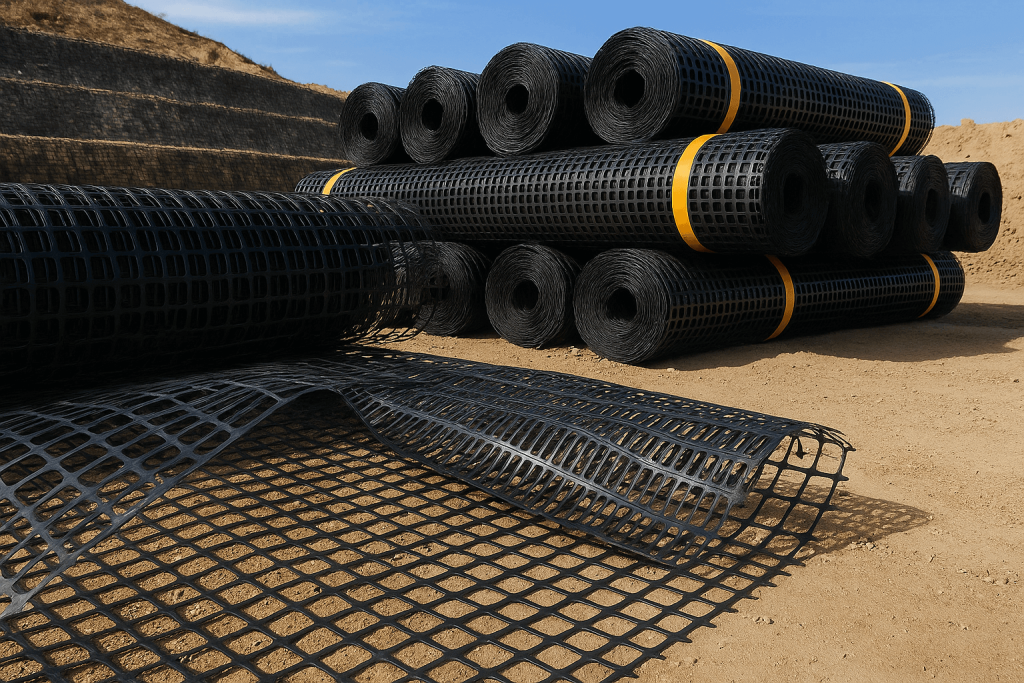
In the world of civil engineering and large-scale construction, stability and durability are everything. One key innovation that continues to revolutionise ground reinforcement and earthworks is the geogrid.
Whether you’re designing a highway embankment, retaining wall, or load-bearing foundation, geogrids offer an efficient and cost-effective solution for soil reinforcement.
But what exactly is a geogrid, and why is it so widely used in construction today?
In this guide, we’ll walk you through everything you need to know about geogrids—from how they work to their core applications—so you can make more informed decisions when specifying or sourcing geosynthetic products for your projects.
A geogrid is a geosynthetic material made from polymer fibres such as polyester, polypropylene, or high-density polyethylene (HDPE). It is characterised by a grid-like structure with open apertures, allowing for interaction with soil or aggregate materials.
Unlike geotextiles, which are typically non-woven or woven sheets, geogrids have a more rigid structure designed specifically for reinforcement. Their strength lies in the ability to interlock with soil, creating a stabilised platform capable of withstanding lateral and vertical loads.
Understanding the type of geogrid you need is critical, as each has its own purpose and performance characteristics. The three main categories include:
One of the primary uses of geogrids is to improve the mechanical properties of soil. By interlocking with aggregate or backfill, geogrids help increase the tensile strength of the ground, preventing shifting, settling, or collapse.
This makes geogrids an essential element in soil reinforcement applications such as:
Geogrids are a preferred choice for reinforcing retaining walls and mechanically stabilised earth (MSE) systems. By adding horizontal layers of geogrid behind the wall face, the structure gains resistance against lateral earth pressure, improving its lifespan and structural integrity.
When sourcing a geo grid for retaining wall, make sure it offers the right tensile strength and compatibility with the wall’s backfill material.
Geogrids significantly enhance road durability by reinforcing the subbase and reducing deformation under load. This helps prevent common problems like rutting, cracking, and sinking, especially in areas with weak or inconsistent soil conditions.
By spreading out loads across a larger surface area, geogrids reduce pressure on subgrade layers. This not only improves bearing capacity but also extends the life of the infrastructure, from highways to container yards.
Using geogrids can reduce the need for expensive soil excavation and replacement. Since geogrids improve the performance of existing soil, they minimise the amount of imported fill or concrete needed, leading to lower construction costs.
When incorporated into civil engineering and construction projects, geogrids offer a range of functional and economic advantages that make them a smart long-term investment.
Geogrids enhance the load-bearing capacity of weak or soft soils, allowing construction on ground that would otherwise be unstable.
By locking soil particles together, geogrids reinforce structures like retaining walls and slopes, reducing the risk of collapse or movement.
They minimise settlement and deformation over time, resulting in longer-lasting roads, embankments, and foundation systems.
With better reinforcement, less imported fill is needed — saving both materials and labour costs.
Geogrids promote eco-friendly building by reducing the use of virgin materials and enabling ground material reuse.
Geogrids are widely used across various sectors of the construction and civil engineering industry, including:
Geogrids are more than just reinforcement materials—they’re critical components in building smarter, safer, and more resilient infrastructure. Whether you’re looking to stabilise weak soils, support a retaining wall, or extend the life of a road, geogrids offer proven benefits that justify their widespread adoption.
If you’re involved in the construction industry or geosynthetic product supply chain, now’s the time to explore how geogrids can enhance your projects—from soil reinforcement to geo grid for retaining wall systems.
🔍 Looking for the right geogrid for your construction needs?
Work with a trusted geosynthetic supplier who can advise on the best type, strength rating, and installation method for your specific project.
Copyright © Gateway Structure Sdn Bhd (199401025111). All Right Reserved.